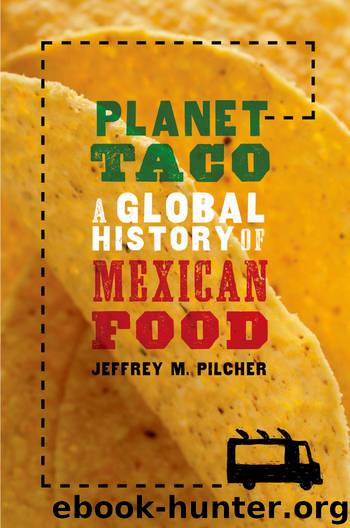Planet Taco by Pilcher Jeffrey M

Author:Pilcher, Jeffrey M.
Language: eng
Format: epub
Publisher: Oxford University Press, USA
Published: 2012-10-23T16:00:00+00:00
Ethnic and National Cuisines
Similar forces of industrialization and nationalism helped to consolidate Mexican and Mexican American regional cuisines in the mid-twentieth century.
The power of nationalism to standardize cultures within borders while exaggerating cross-border differences can finally explain the curious evolution of the burrito. Formerly a regional antojito in nineteenth-century Guanajuato, the burrito was likely obliterated by the spread of the upstart taco in the first half of the twentieth century, reaching out from the nation’s capital to achieve a form of gastronomic and linguistic hegemony. The burrito survived in Sonora and California by taking on a new and distinct identity, cloaked in a wheat flour tortilla, which was itself a relative culinary novelty. Even in California, the taco made inroads, particularly during the formative period of the 1930s and 1940s. While soft tacos came to be associated with relatively small flour tortillas, corn tortillas were transformed into hard tacos, the model for the taco shell. The subsequent spread of Mexican American fast food out of Los Angeles helped to establish what had been a peculiar local nomenclature—burritos and hard and soft tacos—throughout the United States. Migration and food processing thus created an industrial image of Mexican food that was almost completely unrecognizable in Mexico.
Despite these national differences, transnational ties persisted even among the Mexican American generation. Already in 1977, for example, the Monterrey restaurant Regio was serving a recognizable plate of fajitas. Founded as a small fritanga in 1962 by José Inés Cantú Venegas, the restaurant had expanded into a large, elegant dining room, complete with waiters in black and purple uniforms, serving exquisite Hereford meat from local pastures. A Mexican food critic observed: “As a curious detail, meats are not charcoal broiled but broiled with Mexican mesquite shrub kindling, served on a wooden board and on a hot stainless steel plate.”65
Although Mexican American foods developed in a distinctive fashion, they were not completely alienated from home cooking, at least at the time. After all, Mexican American cooks invented the fast-food taco and it was only much later that corporate formulators reworked it. One testament to the power of food to symbolize both Mexican cultural identity and United States citizenship came from Marine Sergeant Roberto Luis Ferrera, who was born in San Luis Potosí and won both the Silver Star and the Purple Heart at Saipan during World War II. Returning home to Los Angeles, he told an interviewer from La Prensa that his greatest wish was “not to be taken from the United States and put in a place where I cannot eat ‘burritos’ and ‘taquitos.’”66
This is not to deny the consequences of segregation in Mexican restaurants, particularly at a psychological level for Mexican workers forced to tolerate rude treatment from clients and the ubiquitous imagery of sombrero-clad peasants. Nevertheless, such stereotypes had become increasingly outdated by the end of this period. In 1967, when Frito-Lay attempted to market their corn chips to Mexicans for the first time, they made a classic advertising blunder by creating the character of the Frito Bandito.
Download
This site does not store any files on its server. We only index and link to content provided by other sites. Please contact the content providers to delete copyright contents if any and email us, we'll remove relevant links or contents immediately.
| Arms Control | Diplomacy |
| Security | Trades & Tariffs |
| Treaties | African |
| Asian | Australian & Oceanian |
| Canadian | Caribbean & Latin American |
| European | Middle Eastern |
| Russian & Former Soviet Union |
The Secret History by Donna Tartt(18802)
The Social Justice Warrior Handbook by Lisa De Pasquale(12124)
Thirteen Reasons Why by Jay Asher(8762)
This Is How You Lose Her by Junot Diaz(6752)
Weapons of Math Destruction by Cathy O'Neil(6116)
Zero to One by Peter Thiel(5657)
Beartown by Fredrik Backman(5574)
The Myth of the Strong Leader by Archie Brown(5400)
The Fire Next Time by James Baldwin(5220)
How Democracies Die by Steven Levitsky & Daniel Ziblatt(5110)
Promise Me, Dad by Joe Biden(5073)
Stone's Rules by Roger Stone(5011)
100 Deadly Skills by Clint Emerson(4821)
A Higher Loyalty: Truth, Lies, and Leadership by James Comey(4820)
Rise and Kill First by Ronen Bergman(4679)
Secrecy World by Jake Bernstein(4615)
The David Icke Guide to the Global Conspiracy (and how to end it) by David Icke(4601)
The Farm by Tom Rob Smith(4419)
The Doomsday Machine by Daniel Ellsberg(4395)
